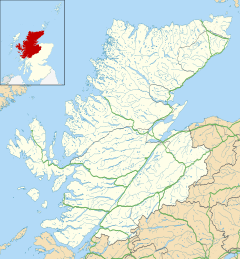Strathrusdale facts for kids
Quick facts for kids Strathrusdale
|
|
|---|---|
| Population | 30 (est.) |
| OS grid reference | NH6174 |
| Council area | |
| Lieutenancy area | |
| Country | Scotland |
| Sovereign state | United Kingdom |
| Post town | Alness |
| Postcode district | IV17 |
| Dialling code | 01349 |
| Police | Northern |
| Fire | Highlands and Islands |
| Ambulance | Scottish |
| EU Parliament | Scotland |
| UK Parliament |
|
| Scottish Parliament | |
Strathrusdale is a beautiful valley, also called a Glen, located in the Scottish Highlands in Scotland. Its name comes from a mix of Scottish Gaelic and Norse words. Strath means 'small valley' in Gaelic, and Rusdale combines rus (Norse for 'ram' or male sheep) with dale (another word for 'small valley').
This valley stretches about 2.5 miles from east to west. The Blackwater river flows through it. At the eastern end, it joins another stream to form the River Alness. The valley floor is mostly open fields where sheep graze. Pine forests surround the strath, except to the north. There, the tall mountain Beinn Tharsuinn stands at 2,831 feet. For a long time, the valley was home to tenant crofters, who were farmers renting small plots of land. In recent years, more new homes have been built, and old ones restored. This is a change after many years when fewer people lived there.
History of Strathrusdale
Ancient Pictish Homes
The very first signs of people living in Strathrusdale can still be seen today. At the eastern end of the valley, you can find several stone circles. These circles were once the foundations of roundhouses built by the Picts. The Picts were an ancient people who lived in this area until about the 10th century. Their land was part of a kingdom called Kingdom of Fortriu. After the 10th century, more Norse people started settling in the area. This led to big changes in the local culture.
The Highland Clearances
The late 1700s brought huge changes to the Scottish Highlands. Landowners realized they could earn more money by clearing out the tenant crofters. They wanted to use the land for sheep farming instead. This period is known as the Highland Clearances. It happened at a time when there was a lot of social unrest in Europe. This made the authorities in Britain feel uneasy.
Strathrusdale became a key place in the clearance policy in 1792. On July 27th, people gathered for a wedding in the valley. There, they planned to drive away all the sheep. This would also mean driving away the sheep farmers. The problem started in May 1792. Two brothers, Captain Allan and Alexander Cameron, were renting land nearby. They had taken cattle belonging to the Strathrusdale people.
The men of Strathrusdale gathered friends from Ardross. They went to Kildermorie, where they found their cattle guarded by the Camerons. Alexander Wallace, known as "Big Wallace," led the Strathrusdale men. Even though the Camerons were strong, they were outnumbered. They had to give up the cattle. One of the Camerons had a loaded gun and a long knife called a dirk. Wallace wrestled with him and took his weapons. The Strathrusdale men got their cattle back.
A week after the wedding meeting, about 400 men from nearby areas took action. They drove about six thousand sheep from the counties of Ross and Sutherland. They moved the sheep towards Beauly in Inverness-shire. The local sheriff, Donald MacLeod, wrote to the Lord Advocate. He asked for soldiers from the 42nd (Black Watch) Regiment to be sent north. MacLeod saw this as an open rebellion.
The Lord Advocate then wrote to the Home Secretary, Henry Dundas. He explained that sheep farming was very unpopular in the Highlands. It forced people to leave their small homes and farms. The Home Secretary replied that strong actions were needed to punish these "daring offenders." He ordered troops to go north.
On Saturday, August 6th, the 42nd Black Watch troops attacked at midnight. The men driving the sheep scattered and went back to their homes. Records from the Inverness County Sheriff Court show that six men were punished for driving the sheep away. Hugh Breck Mackenzie and John Aird were sent away from Britain for seven years. If they returned, they would face severe consequences. Malcolm Ross was fined and imprisoned for one month. William Cunningham was imprisoned for three years. Donald Munro and Alexander Mackay were sent away from Scotland for the rest of their lives. These events were first called the Ross-shire Sheep Riots. Later, they became known as The Year of the Sheep.
Gallery




